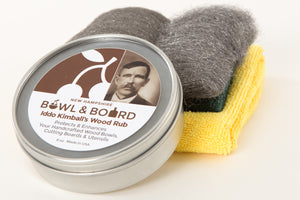- Continue Shopping
- Your Cart is Empty
5 Secrets to Caring for Your Wooden Cutting Board
A wooden cutting board or chopping block is one of the most often used tools in your kitchen so it’s important to take proper care of it. If you don’t, cracking, mold and other damaging factors will start to rear their ugly head. This not only affects the look and life of your board but can also make your cutting board downright unhealthy to use - as bacteria and other nasty stuff collect on its surface.
To ensure longtime use and the safety of your family, there are 5 simple secrets you can follow to take care of your wooden cutting board or chopping block. It doesn’t take a lot of time or money and it will save you a lot of hassle and pocket change in the long run.
1.) Oil Up
Preserving the wood (or seasoning) is the first thing you should do when you bring your cutting board home. This goes for any wooden bowl, wooden spoon or spatula, lazy susans and all wooden utensils. Using oils or natural wood preserving products and conditioners allows the wood fibers to absorb the contents and fortify itself against water and the many other things it will be introduced to on a daily basis. Preserving the wood in this way will protect it from warping or cracking to ensure it serves you well year after year.
Along with keeping your cutting board strong and healthy, seasoning the wood will also help protect it against visible cut marks. Adding oil periodically can even help remove the appearance of existing knife marks and stains.
2.) Wash Smart
Improper cleaning of a wooden cutting board or chopping block can result in food contamination and/or damage to the wood. Food contamination, especially when involving meats, can be very serious and could cause people in your family to get sick if not handled properly. So cleaning the board correctly is something everyone in your household should know how to do.
Though it may be tempting to throw your board in the dishwasher, this is a bad idea as the intense heat, hot air and hard pressure are not good for the wood. When your cutting board is ready to be cleaned, simply hand wash thoroughly with soap and water. We recommend a soft sponge as opposed to a bristly pad or scrub brush because those scratchy surfaces can damage the wood and grain. Never soak your wooden cutting board in water for long periods of time, as this will cause wood fibers to swell and the board will warp.
3.) Deodorize
Though washing your board with soap and water should get it clean enough, there can still be smells and mold you want to get rid of. As anyone who has used a smelly cutting board can attest, it’s not pleasant. Foods can leave some pretty nasty odors (i.e. garlic, fish, onions). You can keep the odors (and bacteria) away with a natural disinfector like baking soda, vinegar or fresh lemon. Add your preferred choice to the cutting board and let it sit for a few minutes. Rinse and dry. This will not only keep it from smelling unpleasant and safe to use, it’s a great way to keep mold and other bacteria from ruining the wood.
4.) Dry Right
Throwing your wooden cutting board in a rack or on the counter after washing to air dry may seem like a fine idea but the last thing you want is for the wood fibers to absorb excess water. This can cause major warping and swelling. To make sure this can’t happen, wipe the board down well with a dry dishtowel after washing until it’s totally dry.
If possible, it’s also a good idea to keep the board in a location that doesn’t see a lot of moisture or water. In other words, by the sink might not be the best place. And try to avoid using your cutting board to set hot or cold items like water glasses or tea/coffee cups on as condensation can collect on the surface and in time ruin the wood.
5.) Maintain the grain
No matter how well you try to take care of your wooden cutting board or chopping block, your wood is going to see a lot of cutting, washing and face a myriad of factors that can affect the surface of the wood. That’s why it’s always a good idea to rub down the surface lightly with a little sandpaper once in a while. This can also help disengage any particles or substances you may not be able to see.
Once you’re done sandpapering and have a smooth and hopefully pristine surface, don’t forget to season and preserve your newly refinished wooden cutting board or chopping block with natural oils.
With these 5 easy tips in mind, your cutting board can continue to be a focal point of your kitchen and culinary passions for generations to come.
Wood Rejuvenating Kit - Wood Care for Neglected Bowls and Boards
from $ 34.99





